The Effects of GPS-Based Buffer Size on the Association between Travel Modes and Environmental Contexts
Abstract
1. Introduction
2. Estimation of Individual Environmental Exposure using Buffer Analysis
3. Method
3.1. GPS Data
3.2. Travel Mode Classification
3.3. Statistical Analyses
4. Result
4.1. Descriptive Statistics
4.2. Sensitivity Analyses of the 11 Sizes of Buffers
5. Discussion and Conclusions
Author Contributions
Funding
Conflicts of Interest
References
- Caspersen, C.J.; Powell, K.E.; Christenson, G.M. Physical activity, exercise, and physical fitness: Definitions and distinctions for health-related research. Public Health Rep. 1985, 100, 126–131. [Google Scholar]
- Physical Activities Guidelines Advisory Committee. Physical Activity Guidelines Advisory Committee Report; US Department of Health and Human Services: Washington, DC, USA, 2008.
- Cohen, D.A.; Ashwood, J.S.; Scott, M.M.; Overton, A.; Evenson, K.R.; Staten, L.K.; Porter, D.; McKenzie, T.L.; Catellier, D. Public Parks and Physical Activity Among Adolescent Girls. Pediatrics 2006, 118, e1381–e1389. [Google Scholar] [CrossRef] [PubMed]
- Coombes, E.; Jones, A.P.; Hillsdon, M. The relationship of physical activity and overweight to objectively measured green space accessibility and use. Soc. Sci. Med. 2010, 70, 816–822. [Google Scholar] [CrossRef] [PubMed]
- Nagel, C.L.; Carlson, N.E.; Bosworth, M.; Michael, Y.L. The relation between neighborhood built environment and walking activity among older adults. Am. J. Epidemiol. 2008, 168, 461–468. [Google Scholar] [CrossRef] [PubMed]
- Schipperijn, J.; Bentsen, P.; Troelsen, J.; Toftager, M.; Stigsdotter, U.K. Associations between physical activity and characteristics of urban green space. Urban For. Urban Green. 2013, 12, 109–116. [Google Scholar] [CrossRef]
- McGinn, A.P.; Evenson, K.R.; Herring, A.H.; Huston, S.L.; Rodriguez, D.A. Exploring associations between physical activity and perceived and objective measures of the built environment. J. Urban Health 2007, 84, 162–184. [Google Scholar] [CrossRef] [PubMed]
- Berke, E.M.; Koepsell, T.D.; Moudon, A.V.; Hoskins, R.E.; Larson, E.B. Association of the Built Environment With Physical Activity and Obesity in Older Persons. Am. J. Public Health 2007, 97, 486–492. [Google Scholar] [CrossRef] [PubMed]
- Kwan, M.-P. The Uncertain Geographic Context Problem. Ann. Assoc. Am. Geogr. 2012, 102, 958–968. [Google Scholar] [CrossRef]
- Rodríguez, D.A.; Cho, G.-H.; Evenson, K.R.; Conway, T.L.; Cohen, D.; Ghosh-Dastidar, B.; Pickrel, J.L.; Veblen-Mortenson, S.; Lytle, L.A. Out and about: Association of the built environment with physical activity behaviors of adolescent females. Health Place 2012, 18, 55–62. [Google Scholar] [CrossRef]
- Burgoine, T.; Jones, A.P.; Namenek Brouwer, R.J.; Benjamin Neelon, S.E. Associations between BMI and home, school and route environmental exposures estimated using GPS and GIS: Do we see evidence of selective daily mobility bias in children? Int. J. Health Geogr. 2015, 14, 8. [Google Scholar] [CrossRef]
- Hillsdon, M.; Panter, J.; Foster, C.; Jones, A. The relationship between access and quality of urban green space with population physical activity. Public Health 2006, 120, 1127–1132. [Google Scholar] [CrossRef] [PubMed]
- Maas, J.; Verheij, R.A.; Spreeuwenberg, P.; Groenewegen, P.P. Physical activity as a possible mechanism behind the relationship between green space and health: A multilevel analysis. BMC Public Health 2008, 8, 206. [Google Scholar] [CrossRef] [PubMed]
- Mitchell, C.; Clark, A.; Gilliland, J. Built Environment Influences of Children’s Physical Activity: Examining Differences by Neighbourhood Size and Sex. Int. J. Environ. Res. Public Health 2016, 13, 130. [Google Scholar] [CrossRef] [PubMed]
- Chambers, T.; Pearson, A.L.; Kawachi, I.; Rzotkiewicz, Z.; Stanley, J.; Smith, M.; Barr, M.; Ni Mhurchu, C.; Signal, L. Kids in space: Measuring children’s residential neighborhoods and other destinations using activity space GPS and wearable camera data. Soc. Sci. Med. 2017, 193, 41–50. [Google Scholar] [CrossRef]
- Cerin, E.; Mitáš, J.; Cain, K.L.; Conway, T.L.; Adams, M.A.; Schofield, G.; Sarmiento, O.L.; Reis, R.S.; Schipperijn, J.; Davey, R.; et al. Do associations between objectively-assessed physical activity and neighbourhood environment attributes vary by time of the day and day of the week? IPEN adult study. Int. J. Behav. Nutr. Phys. Act. 2017, 14, 34. [Google Scholar] [CrossRef]
- Browning, M.; Lee, K. Within what distance does “Greenness” best predict physical health? A systematic review of articles with GIS buffer analyses across the lifespan. Int. J. Environ. Res. Public Health 2017, 14, 675. [Google Scholar] [CrossRef]
- Boruff, B.J.; Nathan, A.; Nijënstein, S. Using GPS technology to (re)-examine operational definitions of ‘neighbourhood’ in place-based health research. Int. J. Health Geogr. 2012, 11, 22. [Google Scholar] [CrossRef]
- Almanza, E.; Jerrett, M.; Dunton, G.; Seto, E.; Ann Pentz, M. A study of community design, greenness, and physical activity in children using satellite, GPS and accelerometer data. Health Place 2012, 18, 46–54. [Google Scholar] [CrossRef]
- Dunton, G.F.; Almanza, E.; Jerrett, M.; Wolch, J.; Pentz, M.A. Neighborhood Park Use by Children. Am. J. Prev. Med. 2014, 46, 136–142. [Google Scholar] [CrossRef]
- James, P.; Berrigan, D.; Hart, J.E.; Aaron Hipp, J.; Hoehner, C.M.; Kerr, J.; Major, J.M.; Oka, M.; Laden, F. Effects of buffer size and shape on associations between the built environment and energy balance. Health Place 2014, 27, 162–170. [Google Scholar] [CrossRef]
- Hirsch, J.A.; Winters, M.; Ashe, M.C.; Clarke, P.J.; McKay, H.A. Destinations That Older Adults Experience Within Their GPS Activity Spaces: Relation to Objectively Measured Physical Activity. Environ. Behav. 2016, 48, 55–77. [Google Scholar] [CrossRef] [PubMed]
- Prins, R.G.; Pierik, F.; Etman, A.; Sterkenburg, R.P.; Kamphuis, C.B.M.; Van Lenthe, F.J. How many walking and cycling trips made by elderly are beyond commonly used buffer sizes: Results from a GPS study. Health Place 2014, 27, 127–133. [Google Scholar] [CrossRef] [PubMed]
- Harrison, F.; Burgoine, T.; Corder, K.; Van Sluijs, E.M.; Jones, A. How well do modelled routes to school record the environments children are exposed to? A cross-sectional comparison of GIS-modelled and GPS-measured routes to school. Int. J. Health Geogr. 2014, 13, 5. [Google Scholar] [CrossRef] [PubMed]
- Yin, L.; Raja, S.; Li, X.; Lai, Y.; Epstein, L.; Roemmich, J. Neighbourhood for Playing: Using GPS, GIS and Accelerometry to Delineate Areas within which Youth are Physically Active. Urban Stud. 2013, 50, 2922–2939. [Google Scholar] [CrossRef]
- Houston, D. Implications of the modifiable areal unit problem for assessing built environment correlates of moderate and vigorous physical activity. Appl. Geogr. 2014, 50, 40–47. [Google Scholar] [CrossRef]
- Kwan, M.-P. The Limits of the Neighborhood Effect: Contextual Uncertainties in Geographic, Environmental Health, and Social Science Research. Ann. Am. Assoc. Geogr. 2018, 108, 1482–1490. [Google Scholar] [CrossRef]
- Lee, K.; Kwan, M. Automatic physical activity and in-vehicle status classification based on GPS and accelerometer data: A hierarchical classification approach using machine learning techniques. Trans. GIS 2018, 22, 1522–1549. [Google Scholar] [CrossRef]
- Zenk, S.N.; Schulz, A.J.; Matthews, S.A.; Odoms-Young, A.; Wilbur, J.; Wegrzyn, L.; Gibbs, K.; Braunschweig, C.; Stokes, C. Activity space environment and dietary and physical activity behaviors: A pilot study. Health Place 2011, 17, 1150–1161. [Google Scholar] [CrossRef]
- Hirsch, J.A.; Winters, M.; Clarke, P.; McKay, H. Generating GPS activity spaces that shed light upon the mobility habits of older adults: A descriptive analysis. Int. J. Health Geogr. 2014, 13, 51. [Google Scholar] [CrossRef]
- Perchoux, C.; Kestens, Y.; Thomas, F.; Hulst, A.V.; Thierry, B.; Chaix, B. Assessing patterns of spatial behavior in health studies: Their socio-demographic determinants and associations with transportation modes (the RECORD Cohort Study). Soc. Sci. Med. 2014, 119, 64–73. [Google Scholar] [CrossRef]
- Lee, N.C.; Voss, C.; Frazer, A.D.; Hirsch, J.A.; McKay, H.A.; Winters, M. Does activity space size influence physical activity levels of adolescents?—A GPS study of an urban environment. Prev. Med. Rep. 2016, 3, 75–78. [Google Scholar] [CrossRef] [PubMed]
- Rundle, A.G.; Sheehan, D.M.; Quinn, J.W.; Bartley, K.; Eisenhower, D.; Bader, M.M.D.; Lovasi, G.S.; Neckerman, K.M. Using GPS Data to Study Neighborhood Walkability and Physical Activity. Am. J. Prev. Med. 2016, 50, e65–e72. [Google Scholar] [CrossRef] [PubMed]
- Thierry, B.; Chaix, B.; Kestens, Y. Detecting activity locations from raw GPS data: A novel kernel-based algorithm. Int. J. Health Geogr. 2013, 12, 14. [Google Scholar] [CrossRef] [PubMed]
- Jankowska, M.M.; Natarajan, L.; Godbole, S.; Meseck, K.; Sears, D.D.; Patterson, R.E.; Kerr, J. Kernel Density Estimation as a Measure of Environmental Exposure Related to Insulin Resistance in Breast Cancer Survivors. Cancer Epidemiol. Prev. Biomark. 2017, 26, 1078–1084. [Google Scholar] [CrossRef]
- Kwan, M.-P. Gender and Individual Access to Urban Opportunities: A Study Using Space–Time Measures. Prof. Geogr. 1999, 51, 211–227. [Google Scholar] [CrossRef]
- Wang, J.; Kwan, M.-P. An Analytical Framework for Integrating the Spatiotemporal Dynamics of Environmental Context and Individual Mobility in Exposure Assessment: A Study on the Relationship between Food Environment Exposures and Body Weight. Int. J. Environ. Res. Public Health 2018, 15, 2022. [Google Scholar] [CrossRef]
- Gong, Y.; Gallacher, J.; Palmer, S.; Fone, D. Neighbourhood green space, physical function and participation in physical activities among elderly men: The Caerphilly Prospective study. Int. J. Behav. Nutr. Phys. Act. 2014, 11, 40. [Google Scholar] [CrossRef]
- McMorris, O.; Villeneuve, P.J.; Su, J.; Jerrett, M. Urban greenness and physical activity in a national survey of Canadians. Environ. Res. 2015, 137, 94–100. [Google Scholar] [CrossRef]
- Troped, P.J.; Saunders, R.P.; Pate, R.R.; Reininger, B.; Addy, C.L. Correlates of recreational and transportation physical activity among adults in a New England community. Prev. Med. 2003, 37, 304–310. [Google Scholar] [CrossRef]
- Sallis, J.F.; Bowles, H.R.; Bauman, A.; Ainsworth, B.E.; Bull, F.C.; Craig, C.L.; Sjöström, M.; De Bourdeaudhuij, I.; Lefevre, J.; Matsudo, V.; et al. Neighborhood Environments and Physical Activity Among Adults in 11 Countries. Am. J. Prev. Med. 2009, 36, 484–490. [Google Scholar] [CrossRef]
- Gómez, L.F.; Parra, D.C.; Buchner, D.; Brownson, R.C.; Sarmiento, O.L.; Pinzón, J.D.; Ardila, M.; Moreno, J.; Serrato, M.; Lobelo, F. Built Environment Attributes and Walking Patterns Among the Elderly Population in Bogotá. Am. J. Prev. Med. 2010, 38, 592–599. [Google Scholar] [CrossRef] [PubMed]
- Astell-Burt, T.; Feng, X.; Kolt, G.S. Green space is associated with walking and moderate-to-vigorous physical activity (MVPA) in middle-to-older-aged adults: Findings from 203 883 Australians in the 45 and Up Study. Br. J. Sports Med. 2014, 48, 404–406. [Google Scholar] [CrossRef] [PubMed]
- Brown, G.; Schebella, M.F.; Weber, D. Using participatory GIS to measure physical activity and urban park benefits. Landsc. Urban Plan. 2014, 121, 34–44. [Google Scholar] [CrossRef]
- Fisher, K.J.; Li, F.; Michael, Y.; Cleveland, M. Neighborhood-Level Influences on Physical Activity among Older Adults: A Multilevel Analysis. J. Aging Phys. Act. 2004, 12, 45–63. [Google Scholar] [CrossRef]
- Hoehner, C.M.; Brennan Ramirez, L.K.; Elliott, M.B.; Handy, S.L.; Brownson, R.C. Perceived and objective environmental measures and physical activity among urban adults. Am. J. Prev. Med. 2005, 28, 105–116. [Google Scholar] [CrossRef]
- Troped, P.J.; Wilson, J.S.; Matthews, C.E.; Cromley, E.K.; Melly, S.J. The Built Environment and Location-Based Physical Activity. Am. J. Prev. Med. 2010, 38, 429–438. [Google Scholar] [CrossRef]
- Boslaugh, S.E.; Luke, D.A.; Brownson, R.C.; Naleid, K.S.; Kreuter, M.W. Perceptions of Neighborhood Environment for Physical Activity: Is It “Who You Are” or “Where You Live”? J. Urban Health Bull. N. Y. Acad. Med. 2004, 81, 671–681. [Google Scholar] [CrossRef][Green Version]
- Transit Availability Index—CMAP Data Hub. Available online: https://datahub.cmap.illinois.gov/dataset/access-to-transit-index (accessed on 18 July 2019).
- Bureau of Justice Statistics (BJS)—Violent Crime. Available online: https://www.bjs.gov/index.cfm?ty=tp&tid=31 (accessed on 18 July 2019).
- Violent Crimes. Available online: https://www.nij.gov:443/topics/crime/violent/Pages/welcome.aspx (accessed on 18 July 2019).
- Towns, J.; Cockerill, T.; Dahan, M.; Foster, I.; Gaither, K.; Grimshaw, A.; Hazlewood, V.; Lathrop, S.; Lifka, D.; Peterson, G.D.; et al. XSEDE: Accelerating Scientific Discovery. Comput. Sci. Eng. 2014, 16, 62–74. [Google Scholar] [CrossRef]
- Stewart, C.A.; Turner, G.; Vaughn, M.; Gaffney, N.I.; Cockerill, T.M.; Foster, I.; Hancock, D.; Merchant, N.; Skidmore, E.; Stanzione, D.; et al. Jetstream: A self-provisioned, scalable science and engineering cloud environment. In Proceedings of the 2015 XSEDE Conference on Scientific Advancements Enabled by Enhanced Cyberinfrastructure—XSEDE ’15; ACM Press: St. Louis, MO, USA, 2015; pp. 1–8. [Google Scholar]
- Bell, S.L.; Phoenix, C.; Lovell, R.; Wheeler, B.W. Using GPS and geo-narratives: A methodological approach for understanding and situating everyday green space encounters: Using GPS and geo-narratives. Area 2015, 47, 88–96. [Google Scholar] [CrossRef]
- Lee, A.C.K.; Maheswaran, R. The health benefits of urban green spaces: A review of the evidence. J. Public Health 2011, 33, 212–222. [Google Scholar] [CrossRef]
- Foster, S.; Giles-Corti, B. The built environment, neighborhood crime and constrained physical activity: An exploration of inconsistent findings. Prev. Med. 2008, 47, 241–251. [Google Scholar] [CrossRef] [PubMed]
- Badland, H.M.; Schofield, G.M.; Garrett, N. Travel behavior and objectively measured urban design variables: Associations for adults traveling to work. Health Place 2008, 14, 85–95. [Google Scholar] [CrossRef] [PubMed]
- Chaix, B.; Méline, J.; Duncan, S.; Merrien, C.; Karusisi, N.; Perchoux, C.; Lewin, A.; Labadi, K.; Kestens, Y. GPS tracking in neighborhood and health studies: A step forward for environmental exposure assessment, a step backward for causal inference? Health Place 2013, 21, 46–51. [Google Scholar] [CrossRef] [PubMed]
- Sainani, K. The Importance of Accounting for Correlated Observations. PM&R 2010, 2, 858–861. [Google Scholar]
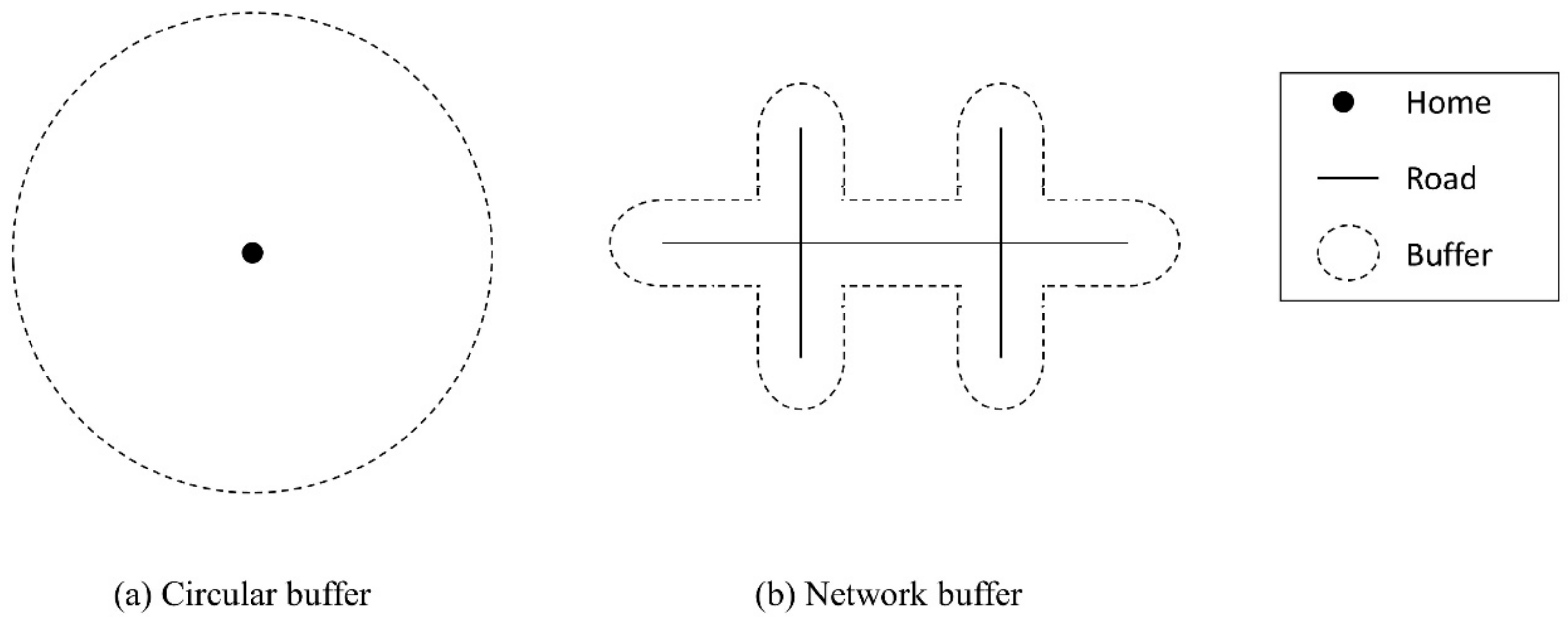
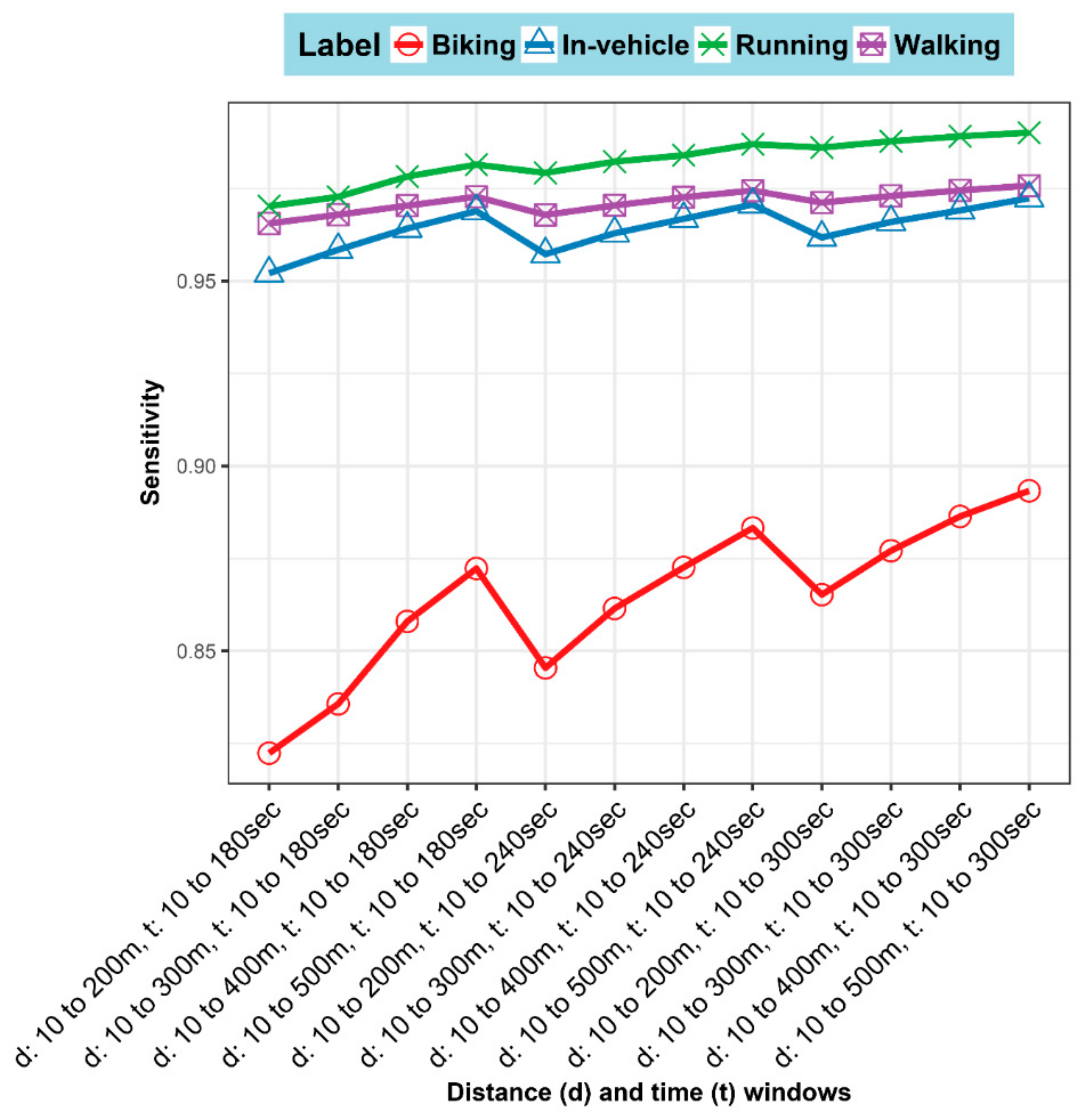
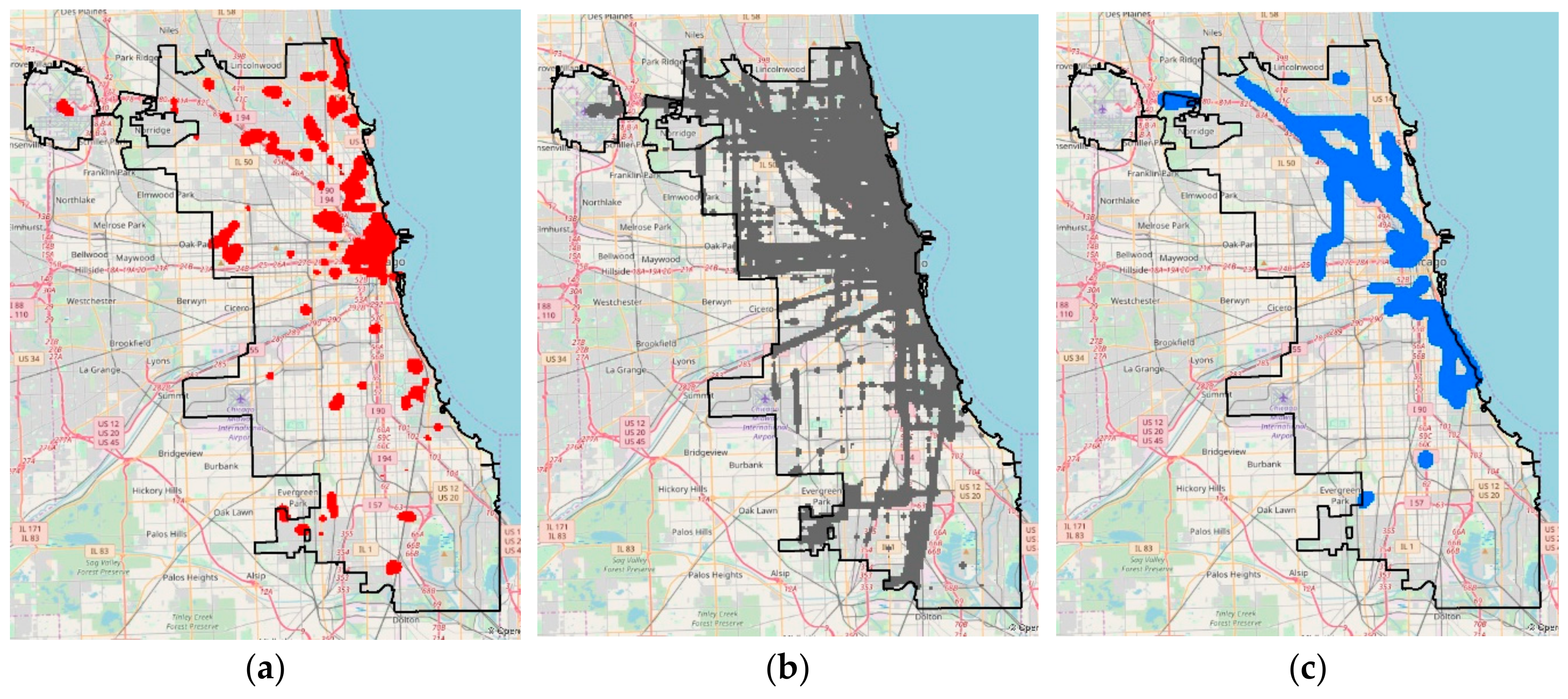
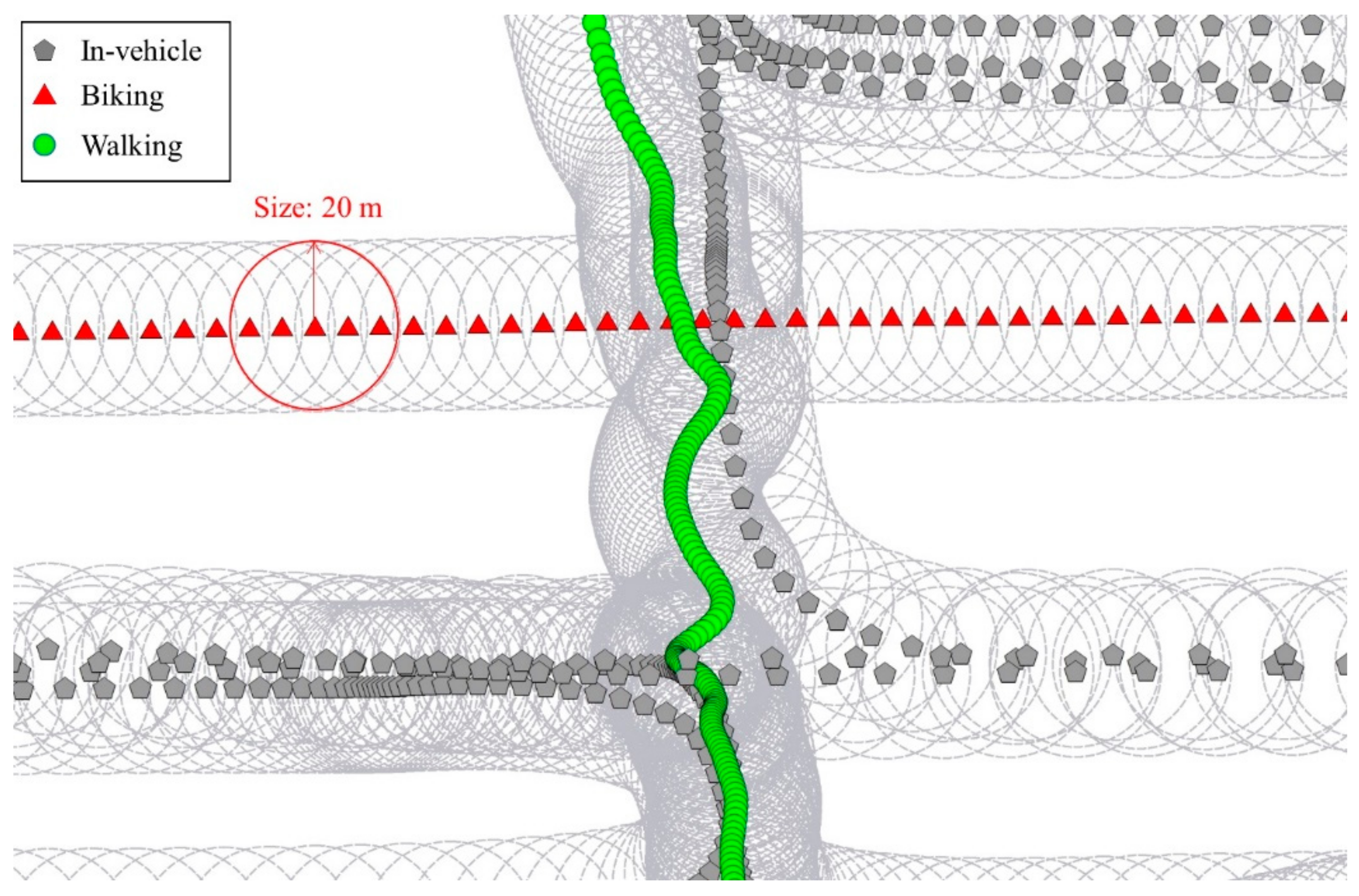
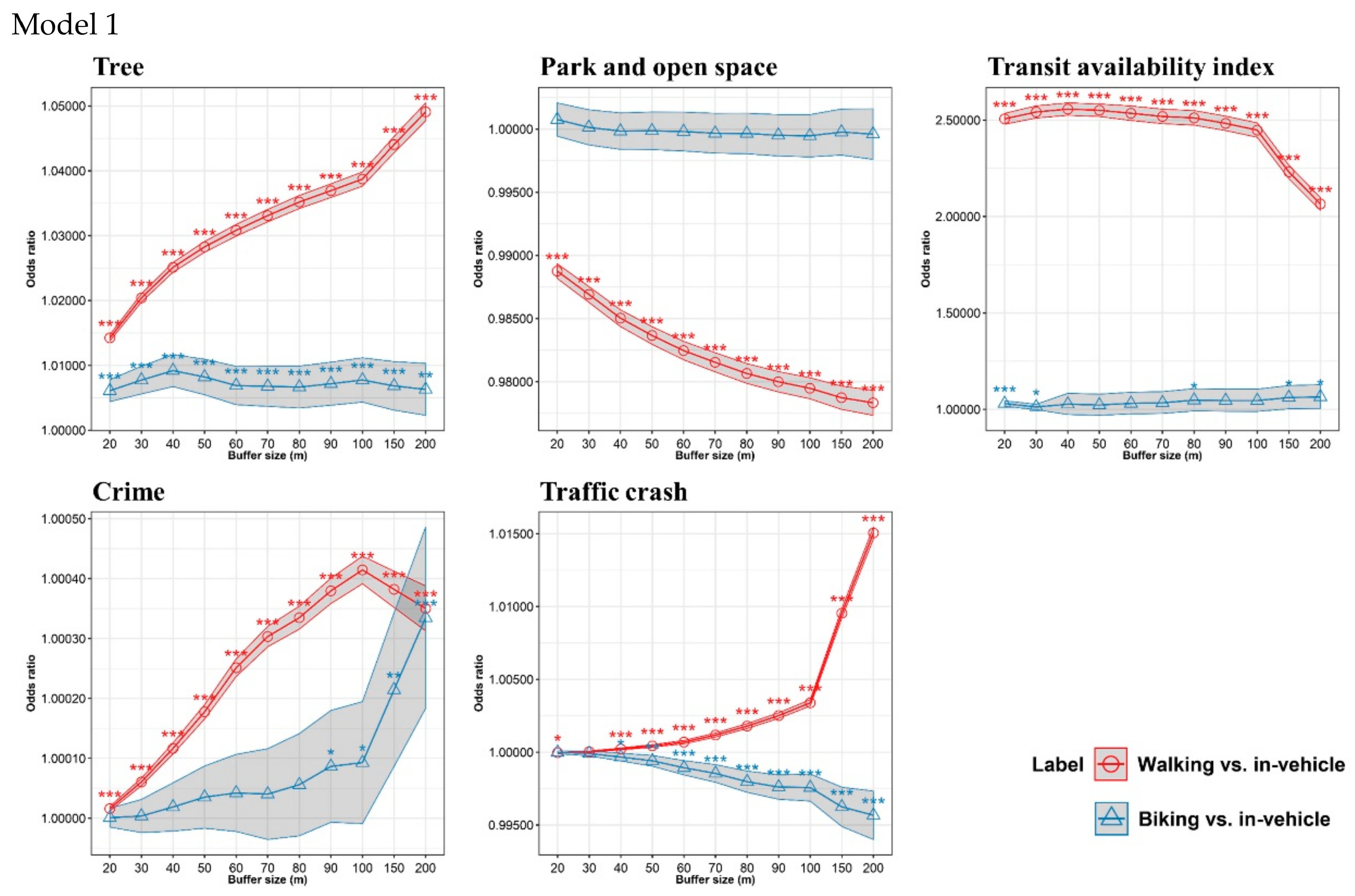

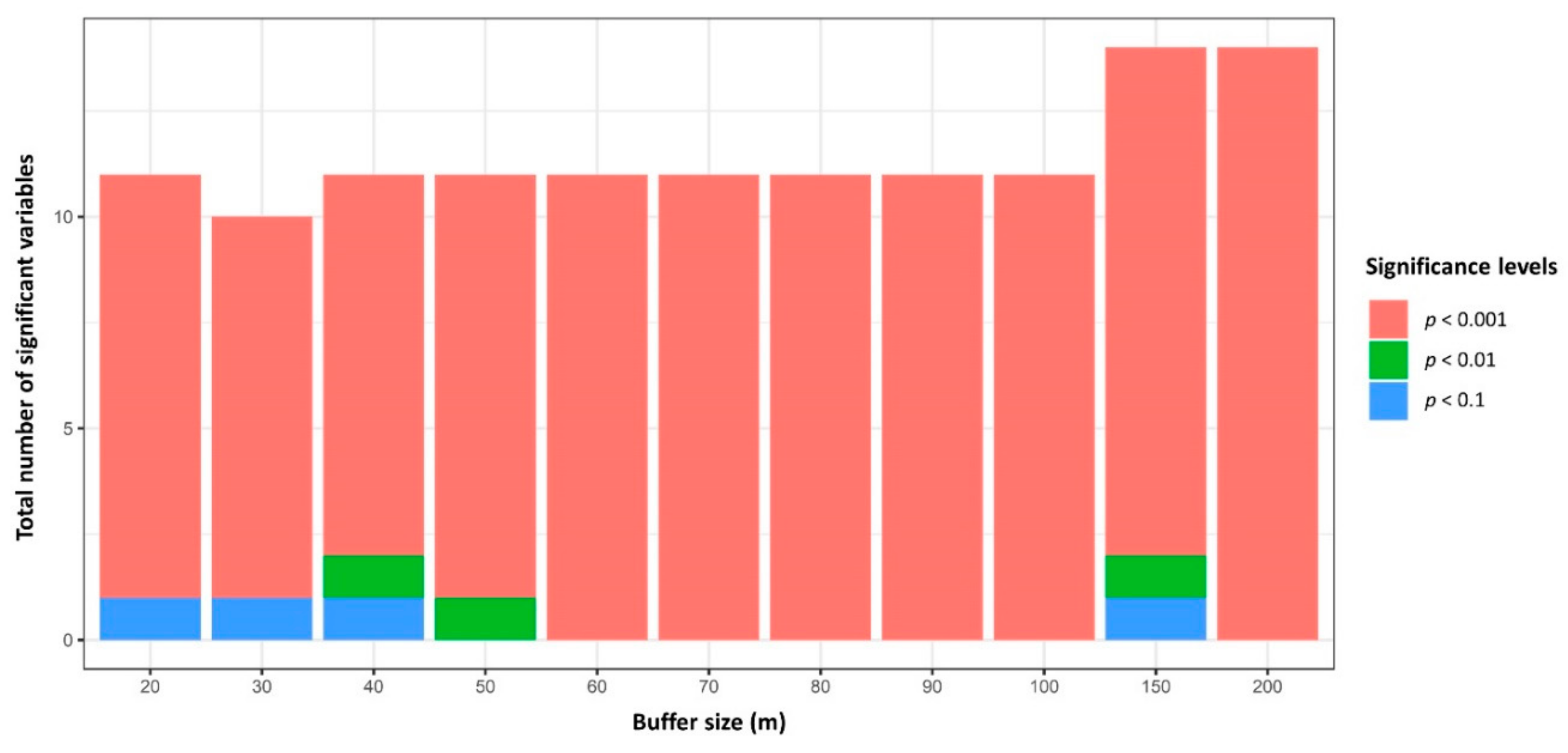
| Category | Predictors | Data Source | Measure | Measuring Unit | Resolution/Unit | Time | Comments |
|---|---|---|---|---|---|---|---|
| Environment | Tree | Land Cover data from the Chicago Metropolitan Agency for Planning Data Hub | Percentage | Area (m2) | 1 m pixel | 2010 | |
| Park and open space | Chicago Data Portal | Percentage | Area (m2) | Polygon | 2010 | ||
| Transport | Transit availability index | Chicago Metropolitan Agency for Planning Data Hub | Average | Index (1–5) | Polygon | 2010 | |
| Safety | Crime | Chicago Data Portal | Count | Number of crimes/km2 | Point | 2007 | Violent crimes |
| Traffic collision | Illinois Department of Transportation | Count | Number of crashes/km2 | Point | 2007 | Pedestrian and pedal cyclists | |
| Neighborhood socio-economy status | Neighborhood median household income | American Community Survey of the United States Census Bureau | Average | Dollars ($) | Census tract (polygon) | 2010 | |
| Density of neighborhood African Americans | American Community Survey of the United States Census Bureau | Average | Number of people/km2 | Census tract (polygon) | 2010 |
| n = 168 Persons | Percentage (%) |
|---|---|
| Female | 53 |
| Race | |
| White | 81.5 |
| African American | 10.7 |
| American Indian or Alaska Native | 1.2 |
| Asian | 1.8 |
| Hispanic | 3.0 |
| Other | 1.8 |
| Household income (73 households) | |
| < $20,000 | 8.7 |
| $20,000–$34,999 | 5.4 |
| $35,000–$49,999 | 3.3 |
| $50,000–$59,999 | 9.8 |
| $60,000 to $74,999 | 10.9 |
| $75,000 to $99,999 | 21.7 |
| $100,000+ | 39.1 |
| NA | 1.1 |
| Mean ± standard deviation | |
| Age | 43.2 ± 11.4 |
| Predicted average daily travel time (hours) | |
| Walking | 0.3 ± 0.2 |
| Running | 0.0003 ± 0.0 |
| Biking | 0.02 ± 0.5 |
| In-vehicle | 1.1 ± 0.7 |
| Number of recorded days | 5.3 ± 1.5 |
| Predictors | Walking (40,999 Observations) | Biking (2545 Observations) | In-Vehicle (113,083 Observations) | |||||||||
|---|---|---|---|---|---|---|---|---|---|---|---|---|
| Mean | SD | Min | Max | Mean | SD | Min | Max | Mean | SD | Min | Max | |
| Physical environment | ||||||||||||
| Tree (%) | 18.00 | 19.14 | 0 | 100.00 | 9.00 | 10.49 | 0 | 52.60 | 11.80 | 13.15 | 0 | 100.00 |
| Park and open space (%) | 5.50 | 19.12 | 0 | 100.00 | 8.70 | 25.76 | 0 | 100.00 | 8.00 | 23.73 | 0 | 100.00 |
| Transit availability index (1–5) | 4.67 | 0.46 | 3.41 | 5.00 | 4.31 | 0.45 | 4.00 | 5.00 | 4.47 | 0.51 | 1.00 | 5.00 |
| Social environment and safety | ||||||||||||
| Crime (count/km2) | 41.00 | 74.81 | 0 | 844.00 | 19.90 | 31.94 | 0 | 214.90 | 28.00 | 57.17 | 0 | 1146.00 |
| Neighborhood median household income ($) | 59,484 | 22,832 | 13,177 | 127,736 | 69,253 | 19,753 | 27,866 | 127,460 | 55,161 | 22,122 | 10,217 | 150,281 |
| Density of neighborhood African Americans (population/km2) | 1742 | 2354 | 4 | 10,325 | 269 | 335 | 4 | 2630 | 1207 | 1767 | 0 | 10,325 |
| Traffic collision (count/km2) | 3.80 | 8.65 | 0 | 71.60 | 3.10 | 7.33 | 0 | 47.70 | 3.20 | 7.70 | 0 | 79.60 |
| Predictors | Model 1 | Model 2 | Model 3 | |||||||||||||||
|---|---|---|---|---|---|---|---|---|---|---|---|---|---|---|---|---|---|---|
| Walking Versus in-Vehicle | Biking Versus in-Vehicle | Walking Versus in-Vehicle | Biking Versus in-Vehicle | Walking Versus in-Vehicle | Biking Versus in-Vehicle | |||||||||||||
| OR | 95% CI | AME | OR | 95% CI | AME | OR | 95% CI | AME | OR | 95% CI | AME | OR | 95% CI | AME | OR | 95% CI | AME | |
| Physical environment | ||||||||||||||||||
| Tree | 1.05 | (1.04, 1.05) | 0.0079 | 1.01 | (1.00, 1.01) | −0.0001 | 1.05 | (1.05, 1.05) | 0.0078 | 1.01 | (1.00, 1.01) | −0.0001 | 1.05 | (1.04, 1.05) | 0.0077 | 1.00 | (1.00, 1.00) | −0.0000 |
| Park and open space | 0.97 | (0.97, 0.97) | −0.0036 | 1.00 | (0.99, 1.00) | 0.0001 | 0.97 | (0.97, 0.97) | −0.0036 | 1.00 | (0.99, 1.00) | 0.0001 | 0.98 | (0.97, 0.98) | −0.0033 | 0.99 | (0.99,0.99) | 0.0001 |
| Transit availability index | 2.06 | (2.03, 2.09) | 0.1194 | 1.06 | (1.00, 1.12) | −0.0015 | 2.04 | (2.01, 2.07) | 0.1173 | 1.07 | (1.05, 1.08) | −0.0014 | 1.92 | (1.92, 1.92) | 0.1061 | 1.09 | (1.09, 1.09) | −0.0008 |
| Social environment and safety | ||||||||||||||||||
| Crime | 1.00 | (1.00, 1.00) | 0.0001 | 1.00 | (1.00, 1.00) | 0.0000 | 1.00 | (1.00, 1.00) | 0.0000 | 1.00 | (1.00, 1.00) | 0.0000 | 1.00 | (1.00, 1.00) | 0.0000 | 1.00 | (1.00, 1.00) | 0.0000 |
| Neighborhood median household income | 1.00 | (1.00, 1.00) | 0.0000 | 0.99 | (0.99, 0.99) | −0.0000 | ||||||||||||
| Density of neighborhood African Americans | 1.00 | (1.00, 1.00) | 0.0000 | 1.00 | (1.00, 1.00) | −0.0000 | 1.00 | (1.00, 1.00) | 0.0000 | 0.99 | (0.99, 0.99) | −0.0000 | ||||||
| Traffic collision | 1.01 | (1.01, 1.01) | 0.0025 | 0.99 | (0.99, 0.99) | −0.0001 | 1.01 | (1.01, 1.01) | 0.0027 | 0.99 | (0.99, 0.99) | −0.0001 | 1.01 | (1.01, 1.01) | 0.0021 | 0.99 | (0.99, 0.99) | −0.0001 |
| McFadden’s R2 | 0.128 | 0.129 | 0.140 | |||||||||||||||
| Nagelkerke’s R2 | 0.212 | 0.212 | 0.229 | |||||||||||||||
| CoxSnell’s R2 | 0.154 | 0.155 | 0.167 | |||||||||||||||
| AIC | 178,352 | 178,285 | 175,644 | |||||||||||||||
| BIC | 178,611 | 178,564 | 175,943 | |||||||||||||||
© 2019 by the authors. Licensee MDPI, Basel, Switzerland. This article is an open access article distributed under the terms and conditions of the Creative Commons Attribution (CC BY) license (http://creativecommons.org/licenses/by/4.0/).
Share and Cite
Lee, K.; Kwan, M.-P. The Effects of GPS-Based Buffer Size on the Association between Travel Modes and Environmental Contexts. ISPRS Int. J. Geo-Inf. 2019, 8, 514. https://doi.org/10.3390/ijgi8110514
Lee K, Kwan M-P. The Effects of GPS-Based Buffer Size on the Association between Travel Modes and Environmental Contexts. ISPRS International Journal of Geo-Information. 2019; 8(11):514. https://doi.org/10.3390/ijgi8110514
Chicago/Turabian StyleLee, Kangjae, and Mei-Po Kwan. 2019. "The Effects of GPS-Based Buffer Size on the Association between Travel Modes and Environmental Contexts" ISPRS International Journal of Geo-Information 8, no. 11: 514. https://doi.org/10.3390/ijgi8110514
APA StyleLee, K., & Kwan, M.-P. (2019). The Effects of GPS-Based Buffer Size on the Association between Travel Modes and Environmental Contexts. ISPRS International Journal of Geo-Information, 8(11), 514. https://doi.org/10.3390/ijgi8110514






